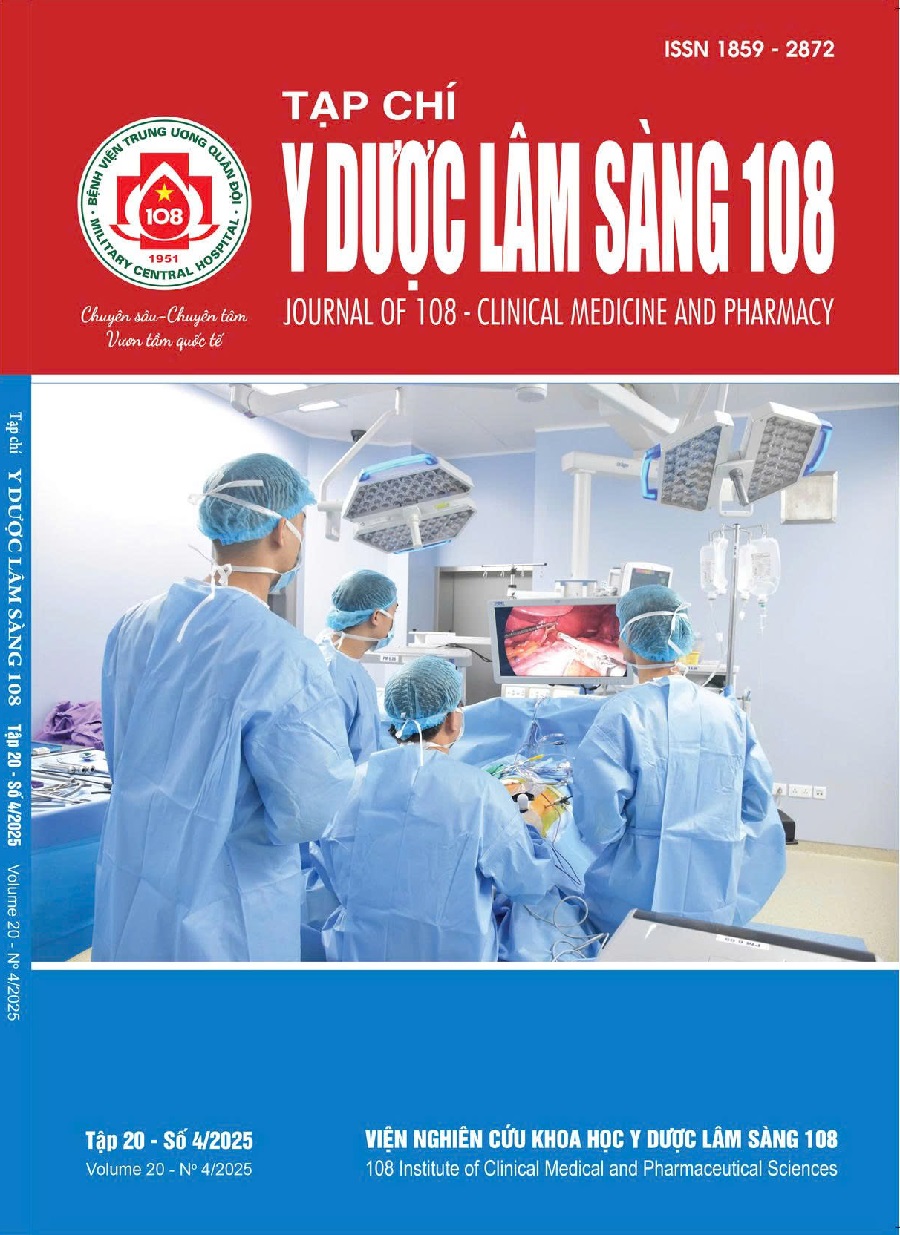Nguyên lý, vai trò và ứng dụng của xét nghiệm đo độ đàn hồi cục máu (ROTEM) trong phẫu thuật tim với tuần hoàn ngoài cơ thể
Main Article Content
Keywords
Tóm tắt
Phẫu thuật tim với tuần hoàn ngoài cơ thể (THNCT) là loại phẫu thuật có nguy cơ cao gây rối loạn đông máu do nhiều nguyên nhân khác nhau. Để điều chỉnh rối loạn đông máu trong phẫu thuật này trước đây thường dựa vào các xét nghiệm đông máu cơ bản nhưng các xét nghiệm này thiếu tính toàn diện về tình trạng đông máu lại có thời gian xét nghiệm thường quá dài để hướng dẫn các quyết định lâm sàng. Đo độ đàn hồi cục máu (ROTEM) là một xét nghiệm đông máu tại chỗ toàn diện hơn, lại cho kết quả nhanh và đáng tin cậy hơn, từ đó giúp hiệu quả hơn trong điều chỉnh rối loạn đông máu. Bài báo cáo này tổng quan nguyên lý, vai trò và ứng dụng của ROTEM để điều chỉnh rối loạn đông máu ở các bệnh nhân phẫu thuật tim với THNCT. Từ đó, sẽ giúp hiểu rõ hơn về xét nghiệm ROTEM và mở ra một hướng mới giúp quá trình gây mê hồi sức cho phẫu thuật tim với THNCT hiệu quả và toàn diện hơn.
Article Details
Các tài liệu tham khảo
2. Korpallová B, Samoš M, Bolek T et al (2018) Role of Thromboelastography and Rotational Thromboelastometry in the Management of Cardiovascular Diseases. Clin Appl Thromb Hemost 24(8): 1199-1207. doi:10.1177/1076029618790092
3. Reardon B, Pasalic L, Favaloro EJ (2024) The Role of Viscoelastic Testing in Assessing Hemostasis: A Challenge to Standard Laboratory Assays? J Clin Med 13(12). doi:10.3390/jcm13123612.
4. Drotarova M, Zolkova J, Belakova KM et al (2023) Basic Principles of Rotational Thromboelastometry (ROTEM®) and the Role of ROTEM Guided Fibrinogen Replacement Therapy in the Management of Coagulopathies. Diagnostics 13(20): 3219.
5. Hartmann J, Hermelin D, Levy JH (2023) Viscoelastic testing: an illustrated review of technology and clinical applications. Res Pract Thromb Haemost 7(1): 100031. doi:10.1016/j.rpth.2022.100031
6. Wells M, Raja M, Rahman S (2022) Point-of-care viscoelastic testing. BJA Educ 22(11): 416-423. doi:10.1016/j.bjae.2022.07.003
7. Nath SS, Pandey CK, Kumar S (2022) Clinical application of viscoelastic point-of-care tests of coagulation-shifting paradigms. Ann Card Anaesth. Jan-Mar 25(1): 1-10. doi:10.4103/aca.aca_319_20
8. Carll T, Wool GD (2020) Basic principles of viscoelastic testing. Transfusion 60(6): 1-9. doi:10.1111/trf.16071
9. Suárez Cuenca J, Gayoso Diz P, Gude Sampedro F, Gómez Zincke JM, Rey Acuña H, Fontanillo Fontanillo MM (2013) Method to calculate the protamine dose necessary for reversal of heparin as a function of activated clotting time in patients undergoing cardiac surgery. J Extra Corpor Technol 45(4): 235-241.
10. Ichikawa J, Kodaka M, Nishiyama K, Hirasaki Y, Ozaki M, Komori M (2014) Reappearance of circulating heparin in whole blood heparin concentration-based management does not correlate with postoperative bleeding after cardiac surgery. J Cardiothorac Vasc Anesth 28(4): 1003-1007. doi:10.1053/j.jvca.2013.10.010.
11. Koster A, Börgermann J, Gummert J, Rudloff M, Zittermann A, Schirmer U (2014) Protamine overdose and its impact on coagulation, bleeding, and transfusions after cardiopulmonary bypass: results of a randomized double-blind controlled pilot study. Clin Appl Thromb Hemost 20(3): 290-295. doi:10.1177/1076029613484085
12. Meesters MI, Veerhoek D, de Lange F et al (2016) Effect of high or low protamine dosing on postoperative bleeding following heparin anticoagulation in cardiac surgery. A randomised clinical trial. Thromb Haemost 116(2): 251-61. doi:10.1160/th16-02-0117
13. Yamamoto T, Wolf HG, Sinzobahamvya N, Asfour B, Hraska V, Schindler E (2015) Prolonged Activated Clotting Time after Protamine Administration Does Not Indicate Residual Heparinization after Cardiopulmonary Bypass in Pediatric Open Heart Surgery. Thorac Cardiovasc Surg 63(5): 397-403. doi:10.1055/s-0035-1554998
14. Karkouti K, Callum J, Crowther MA et al (2013) The relationship between fibrinogen levels after cardiopulmonary bypass and large volume red cell transfusion in cardiac surgery: an observational study. Anesth Analg 117(1): 14-22. doi:10.1213/ANE.0b013e318292efa4
15. Mace H, Lightfoot N, McCluskey S, et al (2016) Validity of Thromboelastometry for Rapid Assessment of Fibrinogen Levels in Heparinized Samples During Cardiac Surgery: A Retrospective, Single-center, Observational Study. J Cardiothorac Vasc Anesth 30(1): 90-95. doi:10.1053/j.jvca.2015.04.030
16. Ranucci M, Baryshnikova E, Crapelli GB, Rahe-Meyer N, Menicanti L, Frigiola A (2015) Randomized, double-blinded, placebo-controlled trial of fibrinogen concentrate supplementation after complex cardiac surgery. J Am Heart Assoc. 4(6):e002066. doi:10.1161/jaha.115.002066
17. Ranucci M, Baryshnikova E, Ranucci M, Silvetti S (2017) Fibrinogen levels compensation of thrombocytopenia-induced bleeding following cardiac surgery. Int J Cardiol 249: 96-100. doi:10.1016/j.ijcard.2017.09.157
18. Schultz-Lebahn A, Nissen PH, Pedersen TF, Tang M, Hvas AM (2022) Platelet function assessed by ROTEM(®)platelet in patients receiving antiplatelet therapy during cardiac and vascular surgery. Scand J Clin Lab Invest 82(1): 18-27. doi:10.1080/00365513.2021.2012820
19. Leyra F, Jofre C, Peña N et al (2022) Prediction of platelet counts with ROTEM-sigma in cardiac surgery. Minerva Anestesiol 88(7-8): 573-579. doi:10.23736/s0375-9393.22.15912-2
20. Blasi A, Muñoz G, de Soto I et al (2015) Reliability of thromboelastometry for detecting the safe coagulation threshold in patients taking acenocoumarol after elective heart valve replacement. Thromb Res 136(3): 669-672. doi:10.1016/j.thromres.2015.07.003
21. Schmidt DE, Holmström M, Majeed A, Näslin D, Wallén H, Ågren A (2015) Detection of elevated INR by thromboelastometry and thromboelastography in warfarin treated patients and healthy controls. Thromb Res 135(5): 1007-1011. doi:10.1016/j.thromres.2015.02.022
22. Kallioinen M, Valtonen M, Peltoniemi M et al (2021) Effects of implementing rotational thromboelastometry in cardiac surgery: A retrospective cohort study. J Perioper Pract 31(9): 326-333. doi:10.1177/1750458920950662
23. Herruzo A, Hinojosa R, Adsuar A, Noval JA, Smani T, Ordoñez A (2021) Clinical impact of rotational thromboelastometry in cardiac surgery. Transfus Clin Biol 28(3): 276-282. doi:10.1016/j.tracli.2021.03.003
24. Naguib AN, Carrillo SA, Corridore M et al (2023) A ROTEM-guided algorithm aimed to reduce blood product utilization during neonatal and infant cardiac surgery. J Extra Corpor Technol 55(2): 60-69. doi:10.1051/ject/2023017
25. Vallés-Torres J, Gallego-Ligorit L, González-Rodríguez V, et al (2022) Evaluation of the implementation of rotational thromboelastometry guided coagulation management in adult cardiac surgery. Journal of Cardiothoracic and Vascular Anesthesia 36:12-13. doi:10.1053/j.jvca.2022.09.025
 ISSN: 1859 - 2872
ISSN: 1859 - 2872
